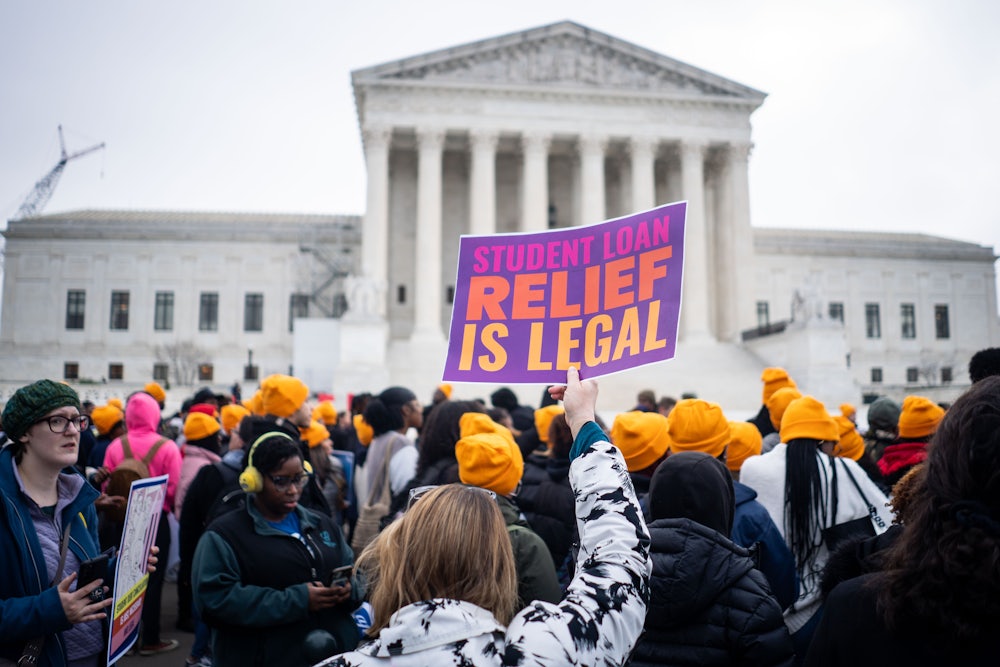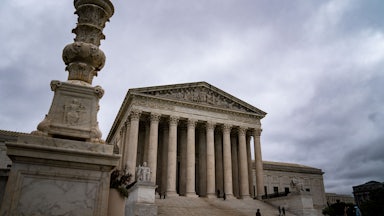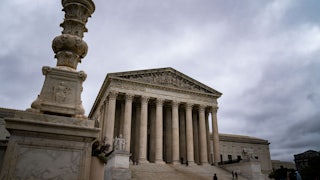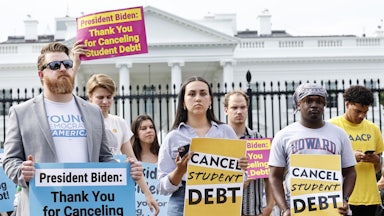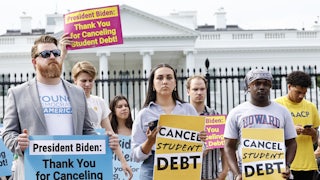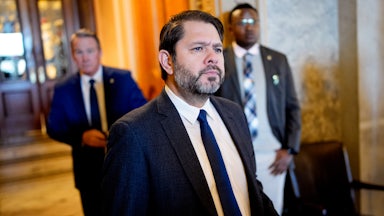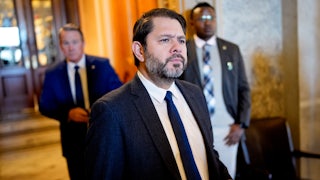The Supreme Court appears inclined to strike down the Biden administration’s student loan debt forgiveness plan, but major procedural hurdles could still hinder the court’s conservatives from unwinding an estimated $400 billion in debt relief that could help as many as 20 million Americans if it goes into effect.
“The case reminds me of the one we had a few years ago under a different administration, where the administration tried acting on its own to cancel the Dreamers program, and we blocked that effort,” Chief Justice John Roberts told Solicitor General Elizabeth Prelogar, referring to the court’s decision in Department of Homeland Security v. Regents of the University of California, where Roberts wrote the majority opinion that blocked the Trump administration from unwinding the program on procedural grounds.
The big hurdle for the justices is whether any of the parties challenging the plan in court have the necessary legal standing to sue the Biden administration over it. Biden v. Nebraska, one of the two cases heard at oral arguments on Tuesday, comes from a coalition of six Republican-led state attorneys general. They argued that they had standing to bring a legal challenge because the relief would affect MOHELA, a student loan servicer created by the state of Missouri as a public corporation.
In Department of Education v. Brown, two individual plaintiffs are challenging the debt relief plan on the grounds that they would be theoretically eligible for even more debt relief if the Biden administration had followed the Administrative Procedures Act. I noted last December that the plaintiffs are represented by the Job Creators Network Foundation, a right-wing advocacy group that opposes student debt relief in general and described the debt relief plan as “fundamentally unfair to the tens of millions of Americans who never went to college or paid their loans back.” The justices generally appeared disinterested in expanding standing to them.
The Trump administration declared a national emergency after the Covid-19 pandemic began in March 2020. Among its relief measures was a freeze on monthly student loan payments and interest. Last summer, the Biden administration said it would end that freeze but also announced plans to forgive up to $20,000 in student debt, depending on the debtors’ income level and whether they obtained Pell grants. Under the Heroes Act of 2003, which Congress passed in anticipation of the Iraq War, the secretary of education can use a national emergency to “waive or modify” many student loan provisions.
That mechanism drew sharp criticism from the court’s conservative members, who took issue with such a bold use of executive power and a sweeping interpretation of statutory authority. “Some of the biggest mistakes in the court’s history were deferring to assertions of executive emergency power,” Justice Brett Kavanaugh told Prelogar. “Some of the finest moments in the court’s history were pushing back against presidential assertions of emergency power.”
A significant portion of the arguments revolved around the “major questions doctrine,” which first emerged roughly two decades ago and surged in importance among the court’s conservative justices in recent years. It holds, in general terms, that Congress must “speak clearly” for federal agencies to take significant regulatory actions on “major questions” of public policy. In practical terms, the major questions doctrine has helped the court’s conservatives strike down federal rules and regulations when they feel that the statutory justification for them is too vague.
Roberts said that there were major separation-of-powers questions about the Biden administration’s maneuver and took issue with the apparent effort to bypass procedural mechanisms. “You’re arguing here that no notice-and-comment proceeding was required before the action taken on the half-trillion dollars of loans and that because of your view that the president can act unilaterally … there was no role for Congress to play in this either, and at least in this case, given your view of standing, there’s no role for us to play in this either,” he stated.
Solicitor General Elizabeth Prelogar, who represented the federal government, argued that the Biden administration had used the authority it had received from Congress under the Heroes Act. And while the government argued that the plaintiffs in the two cases did not have proper standing, she did not rule out that other hypothetical litigants could cross that threshold.
Nebraska Solicitor General James Campbell, who argued on behalf of the states, insisted that the states had proper legal standing to bring the case before the court. “MOHELA is a state-created and state-controlled public instrumentality that performs the essential public function of providing financial aid to Missouri students,” he told the justices in his opening remarks. “The [administration]’s program threatens to cut MOHELA’s operating revenue by 40 percent.”
The court’s three liberal justices disagreed with the states’ view of standing, noting that MOHELA was an independent entity and had the legal authority to bring its own lawsuits, which it declined to do so here. Plaintiffs cannot generally bring claims on behalf of third parties in federal court. Also challenging Missouri’s reasoning on standing was Justice Amy Coney Barrett, who appeared unpersuaded by the states’ assertions that they met that basic threshold.
“If MOHELA is really an arm of the state, all of this would be a lot easier,” she told Campbell. “I mean, the solicitor general conceded that if MOHELA was here, MOHELA would have standing. If MOHELA is an arm of the state, why didn’t you just strong-arm MOHELA and say you’ve got to pursue this suit?” Campbell replied that it was “a question of state politics,” which prompted Justice Elena Kagan to note that Missouri had to file the equivalent of a FOIA request to get documents from MOHELA for the litigation.
Only Justice Samuel Alito appeared openly ready to accept that the states had standing to bring the lawsuit. The conservative justices were much more forthright about their disdain for the debt relief policy in general. During the Brown arguments, Roberts contrasted the choices between a hypothetical person who chose to forgo college in favor of starting a lawn-care business with a bank loan, and a hypothetical person who went to college, took out loans, and then had them forgiven by the government.
Roberts suggested it was unfair for the hypothetical guy who started the business to subsidize loan forgiveness for the hypothetical guy who went to college. “Now why isn’t that a factor that should enter into our consideration under the major questions doctrine again, where we look at things a little more strictly than we might otherwise when we’re talking about statutory grants of authority, to make sure that this is something that Congress would have contemplated?” he asked.
Justice Neil Gorsuch also raised a similar point. “What I think [the states] argue that is missing is costs to other persons in terms of fairness, for example, people who have paid their loans, people who don’t plan their lives around not seeking loans, and people who are not eligible for loans in the first place, and that a half a trillion dollars is being diverted to one group of favored persons over others,” he remarked to Prelogar during the Nebraska arguments.
Prelogar, for her part, noted that Congress makes these judgment calls all the time. She pointed to the arsenal of other pandemic relief mechanisms that Congress enacted in 2020, including loans to small businesses that were largely forgiven. “For the states to suggest that it’s incumbent on the secretary [of education] to say, ‘Actually, I’m not going to do that, even though Congress wanted me to ensure that borrowers won’t be left worse off,’ is just at war with the whole statutory purpose,” she told Gorsuch.
Whether the justices’ disdain will outweigh the standing arguments is now in the justices’ hands. A ruling is likely to come by the end of June. If the court rules against the debt relief plan in its current form, the administration will be hard-pressed to revive it before the Covid-19 national emergency is scheduled to end in May. With a Republican majority in the House, that would likely doom student debt relief efforts for the remainder of Biden’s term. Barrett and the court’s liberals may yet find a fifth vote to toss out the entire case on standing grounds. But if the justices allow the policy to take effect, it will be through gritted teeth.
